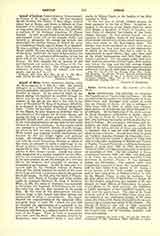

Arnulf of Metz, Saint, statesman, bishop under the Merovingians, B. C. 580; d. c. 640. His parents belonged to a distinguished Frankish family, and lived in Austrasia, the eastern section of the kingdom founded by Clovis. In the school in which he was placed during his boyhood he excelled through his talent and his good behavior. According to the custom of the age, he was sent in due time to the court of Theodebert II, King of Austrasia (595-612), to be initiated in the various branches of the government. Under the guidance of Gundulf, the Mayor of the Palace, he soon became so proficient that he was placed on the regular list of royal officers, and among the first of the king’s ministers. He distinguished himself both as a military commander and in the civil administration; at one time he had under his care six distinct provinces. In due course Arnulf was married to a Frankish woman of noble lineage, by whom he had two sons, Anseghisel and Clodulf. While Arnulf was enjoying worldly emoluments and honors he did not forget higher and spiritual things. His thoughts dwelled often on monasteries, and with his friend Romaricus, likewise an officer of the court, he planned to make a pilgrimage to the Abbey of Lerins, evidently for the purpose of devoting his life to God. But in the meantime the Episcopal See of Metz became vacant. Arnulf was universally designated as a worthy candidate for the office, and he was consecrated bishop of that see about 611. In his new position he set the example of a virtuous life to his subjects, and attended to matters of ecclesiastical government. In 625 he took part in a council held by the Frankish bishops at Reims. With all this Arnulf retained his station at the court of the king, and took a prominent part in the national life of his people. In 613, after the death of Theodebert, he, with Pepin of Landen and other nobles, called to Austrasia Clothaire II, King of Neustria. When, in 623, the realm of Austrasia was entrusted to the king’s son Dagobert, Arnulf became not only the tutor, but also the chief minister, of the young king. At the time of the estrangement between the two kings, in 625, Arnulf with other bishops and nobles tried to effect a reconciliation. But Arnulf dreaded the responsibilities of the episcopal office, and grew weary of court life. About the year 626 he obtained the appointment of a successor to the Episcopal See of Metz; he himself and his friend Romaricus withdrew to a solitary place in the mountains of the Vosges. There he lived in communion with God until his death. His remains, interred by Romaricus, were transferred about a year afterwards, by Bishop Goeric, to the basilica of the Holy Apostles in Metz.
Of the two sons of Arnulf, Clodulf became his third successor in the See of Metz. Anseghisel remained in the service of the State; from his union with Begga, a daughter of Pepin of Landen, was born Pepin of Heristal, the founder of the Carlovingian dynasty. In this manner Arnulf was the ancestor of the mighty rulers of that house. The life of Arnulf exhibits to a certain extent the episcopal office and career in the Merovingian State. The bishops were much considered at court; their advice was listened to; they took part in the dispensation of justice by the courts; they had a voice in the appointment of royal officers; they were often used as the king’s ambassadors, and held high administrative positions. For the people under their care, they were the protectors of their rights, their spokesmen before the king and the link uniting royalty with its subjects. The opportunities for good were thus unlimited; and Arnulf used them to good advantage.
FRANCIS J. SCHAEFER

